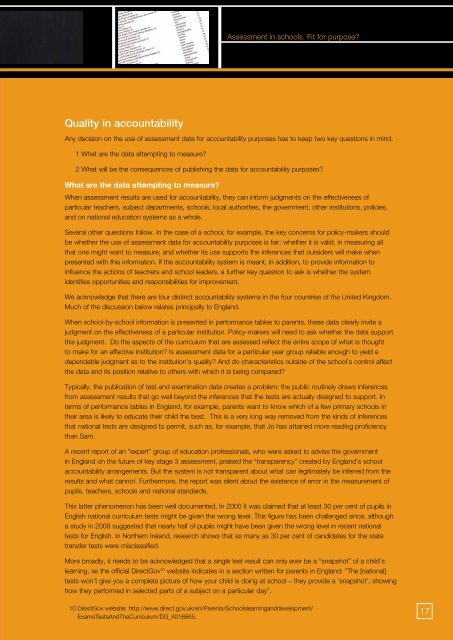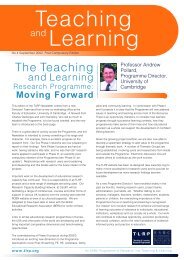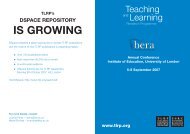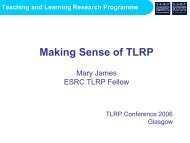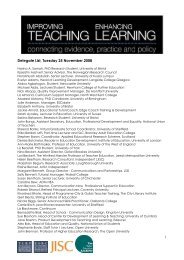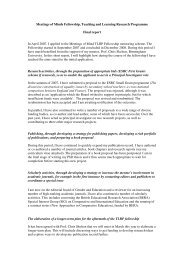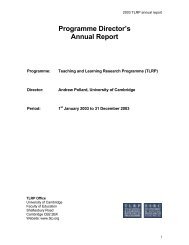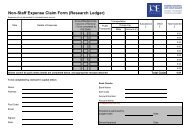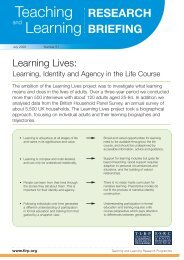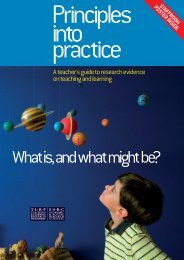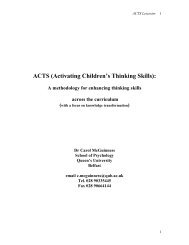Assessment in schools Fit for purpose? - Teaching and Learning ...
Assessment in schools Fit for purpose? - Teaching and Learning ...
Assessment in schools Fit for purpose? - Teaching and Learning ...
You also want an ePaper? Increase the reach of your titles
YUMPU automatically turns print PDFs into web optimized ePapers that Google loves.
Quality <strong>in</strong> accountability<br />
<strong>Assessment</strong> <strong>in</strong> <strong>schools</strong>. <strong>Fit</strong> <strong>for</strong> <strong>purpose</strong>?<br />
Any decision on the use of assessment data <strong>for</strong> accountability <strong>purpose</strong>s has to keep two key questions <strong>in</strong> m<strong>in</strong>d.<br />
1 What are the data attempt<strong>in</strong>g to measure?<br />
2 What will be the consequences of publish<strong>in</strong>g the data <strong>for</strong> accountability <strong>purpose</strong>s?<br />
What are the data attempt<strong>in</strong>g to measure?<br />
When assessment results are used <strong>for</strong> accountability, they can <strong>in</strong><strong>for</strong>m judgments on the effectiveness of<br />
particular teachers, subject departments, <strong>schools</strong>, local authorities, the government, other <strong>in</strong>stitutions, policies,<br />
<strong>and</strong> on national education systems as a whole.<br />
Several other questions follow. In the case of a school, <strong>for</strong> example, the key concerns <strong>for</strong> policy-makers should<br />
be whether the use of assessment data <strong>for</strong> accountability <strong>purpose</strong>s is fair; whether it is valid, <strong>in</strong> measur<strong>in</strong>g all<br />
that one might want to measure; <strong>and</strong> whether its use supports the <strong>in</strong>ferences that outsiders will make when<br />
presented with this <strong>in</strong><strong>for</strong>mation. If the accountability system is meant, <strong>in</strong> addition, to provide <strong>in</strong><strong>for</strong>mation to<br />
<strong>in</strong>fluence the actions of teachers <strong>and</strong> school leaders, a further key question to ask is whether the system<br />
identifies opportunities <strong>and</strong> responsibilities <strong>for</strong> improvement.<br />
We acknowledge that there are four dist<strong>in</strong>ct accountability systems <strong>in</strong> the four countries of the United K<strong>in</strong>gdom.<br />
Much of the discussion below relates pr<strong>in</strong>cipally to Engl<strong>and</strong>.<br />
When school-by-school <strong>in</strong><strong>for</strong>mation is presented <strong>in</strong> per<strong>for</strong>mance tables to parents, these data clearly <strong>in</strong>vite a<br />
judgment on the effectiveness of a particular <strong>in</strong>stitution. Policy-makers will need to ask whether the data support<br />
this judgment. Do the aspects of the curriculum that are assessed reflect the entire scope of what is thought<br />
to make <strong>for</strong> an effective <strong>in</strong>stitution? Is assessment data <strong>for</strong> a particular year group reliable enough to yield a<br />
dependable judgment as to the <strong>in</strong>stitution’s quality? And do characteristics outside of the school’s control affect<br />
the data <strong>and</strong> its position relative to others with which it is be<strong>in</strong>g compared?<br />
Typically, the publication of test <strong>and</strong> exam<strong>in</strong>ation data creates a problem: the public rout<strong>in</strong>ely draws <strong>in</strong>ferences<br />
from assessment results that go well beyond the <strong>in</strong>ferences that the tests are actually designed to support. In<br />
terms of per<strong>for</strong>mance tables <strong>in</strong> Engl<strong>and</strong>, <strong>for</strong> example, parents want to know which of a few primary <strong>schools</strong> <strong>in</strong><br />
their area is likely to educate their child the best. This is a very long way removed from the k<strong>in</strong>ds of <strong>in</strong>ferences<br />
that national tests are designed to permit, such as, <strong>for</strong> example, that Jo has atta<strong>in</strong>ed more read<strong>in</strong>g proficiency<br />
than Sam.<br />
A recent report of an ”expert” group of education professionals, who were asked to advise the government<br />
<strong>in</strong> Engl<strong>and</strong> on the future of key stage 3 assessment, praised the “transparency” created by Engl<strong>and</strong>’s school<br />
accountability arrangements. But the system is not transparent about what can legitimately be <strong>in</strong>ferred from the<br />
results <strong>and</strong> what cannot. Furthermore, the report was silent about the existence of error <strong>in</strong> the measurement of<br />
pupils, teachers, <strong>schools</strong> <strong>and</strong> national st<strong>and</strong>ards.<br />
This latter phenomenon has been well documented. In 2000 it was claimed that at least 30 per cent of pupils <strong>in</strong><br />
English national curriculum tests might be given the wrong level. This figure has been challenged s<strong>in</strong>ce, although<br />
a study <strong>in</strong> 2009 suggested that nearly half of pupils might have been given the wrong level <strong>in</strong> recent national<br />
tests <strong>for</strong> English. In Northern Irel<strong>and</strong>, research shows that as many as 30 per cent of c<strong>and</strong>idates <strong>for</strong> the state<br />
transfer tests were misclassified.<br />
More broadly, it needs to be acknowledged that a s<strong>in</strong>gle test result can only ever be a “snapshot” of a child’s<br />
learn<strong>in</strong>g, as the official DirectGov 10 website <strong>in</strong>dicates <strong>in</strong> a section written <strong>for</strong> parents <strong>in</strong> Engl<strong>and</strong>: “The [national]<br />
tests won’t give you a complete picture of how your child is do<strong>in</strong>g at school – they provide a ‘snapshot’, show<strong>in</strong>g<br />
how they per<strong>for</strong>med <strong>in</strong> selected parts of a subject on a particular day”.<br />
10 DirectGov website: http://www.direct.gov.uk/en/Parents/Schoolslearn<strong>in</strong>g<strong>and</strong>development/<br />
ExamsTestsAndTheCurriculum/DG_4016665.<br />
17


